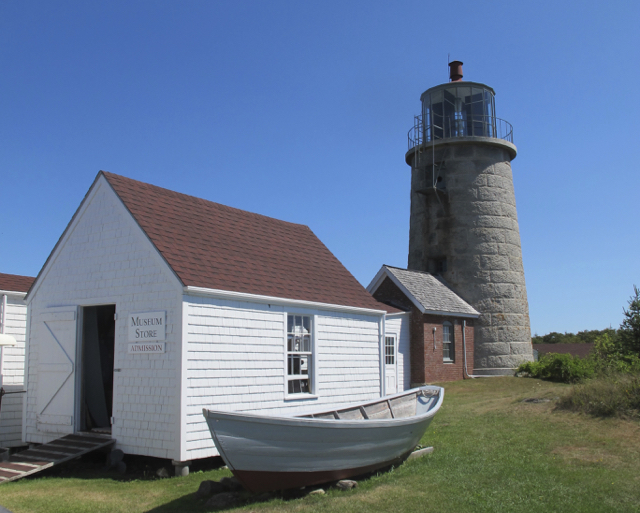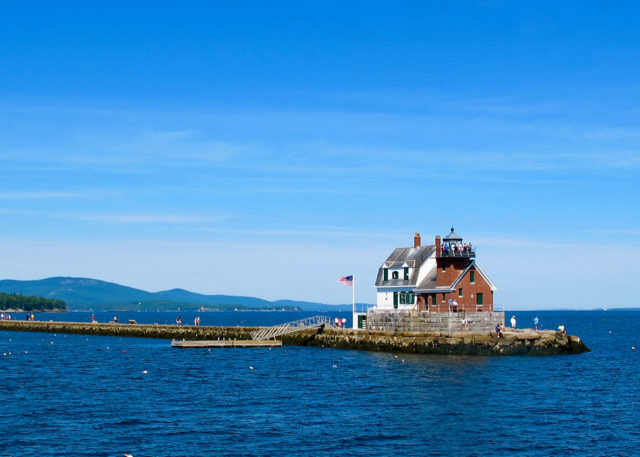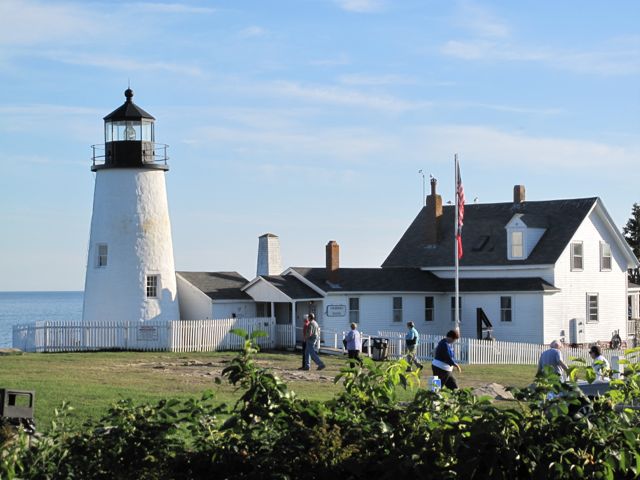Saving lighthouses is not easy task. Credit the Maine Lights Program, launched in 1996, and the National Historical Lighthouse Preservation Act of 2000, for saving more than 40 of Maine’s 64 historical beacons from destruction and neglect. These programs allow transfer of lighthouses to nonprofits or, when none step forward, private parties. Those entrusted with a lighthouse’s care must preserve it with no funding supplied. And if restoring it, must do so accurately. Saving lighthouses requires blind hope, passion, and creative fundraising.
“… by opening the lighthouses and sharing their stories with the public, we get some donations that we put right back into the project.”
—Bob Trapani, president, American Lighthouse Foundation
Burnt Island Lighthouse, Boothbay Harbor

“It’s a labor of love,” says Elaine Jones, Education Director for the Maine’s Department of Marine Resources, about saving lighthouses. When she first learned that Burnt Island Lighthouse, off Boothbay Harbor, was available, it sparked her interest. She needed a place to house teachers during the summer and she envisioned a living history program. While she had the department’s support, there was no money available. The house had been abandoned for 10 years. “The bones were there, but a lot of work had to be done,” she says. A lighthouse is like a boat, she adds, “it’s a hole in the water that you throw money into, only it’s on a rock.”
Jones wrote grants and tugged at heartstrings, approaching locals and summer people. She traveled widely to research the light’s history, making friends in Washington D.C., Rhode Island, and Massachusetts. She chose to portray the year 1950, found 14 keepers who were still alive, and interviewed them and their families. “Every once in a while I’d get a package from the Coast Guard—they found this or that in their files,” she says.
“Once people see you’re enthusiastic and passionate, they jump on the team.” She cobbled together a tremendous support team. “I opened my files as wide as I could and got a lot of free help,” she says, ticking off AmeriCorps, Landmark Volunteers, Master Gardeners, Maine Conservation Corps, teachers, students, and even prisoners. The sons of lightkeeper James McCullough donated their weekends to help to restore their childhood home.
Jones has handed the living history program’s operation to the not-for-profit Keepers of the Burnt Island Light, but she launched a $200,000 fundraising campaign for further restorations. Although ninth-oldest overall, Burnt, constructed in 1821, is the state’s oldest original lighthouse and the first built after Maine became a state. “If I stretch [that truth], in [2021], Maine’s oldest lighthouse will be 200 years old.”
Monhegan Island Light

One of Maine’s earliest lighthouse adaptive reuse projects dates from 1959, when the Coast Guard automated Monhegan Island Light and declared the keeper’s house and outbuildings as surplus. Monhegan Associates, a local conservation nonprofit, envisioned a museum. Island residents responded by donating photographs, documents, furniture, equipment, Indian artifacts, memorabilia, and artwork. When the museum’s collections outgrew the space, the assistant keeper’s house was reconstructed as an art museum, opening in 1998.
Rockland Breakwater Light, Rockland

The Maine-based American Lighthouse Foundation is steward for nine Maine lights, including Rockland Breakwater and Owls Head, which wink at each other across Rockland’s harbor. “From the challenge perspective, [Rockland Breakwater] may as well be an offshore lighthouse,” says ALF president Bob Trapani, noting that volunteers and workers must foot-slog the nearly mile-long breakwater’s uneven granite slabs. Simply restoring the wood floors was a huge project, he adds.
Volunteers endeavor to staff the Rockland Harbor lighthouses throughout the summer season and open the towers to visitors at no charge. “One of the advantages with our volunteer Friends group is that by opening the lighthouses and sharing their stories with the public, we get some donations that we put right back into the project,” Trapani says. “If we do our job, the public actually helps us raise money.”
Little River Light, Cutler
No two restorations are alike, as each provides different challenges. Guests can now overnight for a fee at Cutler’s restored Little River Light. “Its beauty is its remoteness, but that’s also its biggest challenge,” ALF’s Trapani says. Its Friends chapter has raised more than $350,000; no small feat in economically-strapped and sparsely-populated down east Maine.
Perkins Island Lighthouse, Kennebec River
“We own the Perkins Island tower,” Trapani says, referring to the lighthouse on an island in the Kennebec River. Local private residents came forward and donated $50,000 to restore the exterior of the keeper’s house, which is owned by the state. “This couple was just interested in helping and found a creative way and they were able to fund the work,” Trapani says. “Here we were on the verge of potentially loosing the house over the next few years, and it looks awesome now. There’s always hope.”
Head Harbour Lightstation, Campobello Island

Blind hope fueled restoring Head Harbour Lightstation, the 1829 all-wood tower, with its distinctive red-cross pattern, sited on Campobello, a New Brunswick island tethered by bridge to Lubec, Maine. In 2000, a group of senior citizens, primarily women, formed a friends group. Six years later, they took possession of the province’s oldest surviving tower, along with the keeper’s house and outbuildings. “It was a falling down set of five leaking buildings,” volunteer Joyce Morrell says. “We had no clue of what we were getting into. We auctioned off paintings for paint. We scraped, painted, shingled, and kept at it, and it started to look better and better.”
The tower, keeper’s house, and ancillary buildings topped on an offshore rockbound islet. Reaching it required descending and climbing ladders and navigating slippery seaweed- and rock-covered sections of the ocean floor during low tides. On most days, tides limited the treacherous access to a four-hour window. Almost all supplies were carried by hand. Despite the difficulties, they painted the tower twice, wallpapered the interior, hauled over the period furnishings, and even managed to get a refrigerator onto the island and into the house.
As they made progress, more and more visitors ventured over to the island. “They wanted to get inside,” volunteer Deanna Baldwin says. “They peered in the windows, knocked on the door, so we started giving tours to raise funds.” Now the plan is to offer nightly rental. “It’s the most magical place in the world to stay overnight,” she says. “You can sit here and watch the whales, minke, finbacks, humpbacks, sometimes even right whales.”
It’s that kind of excitement that fuels continued interest. “As long as there’s a community heartbeat, an organized effort, people who are energetic and passionate about saving lighthouses, there’s hope,” Trapani says.
For more on Maine’s lighthouses, read: Light up your life: Eight great ways to enjoy Maine’s lighthouses











